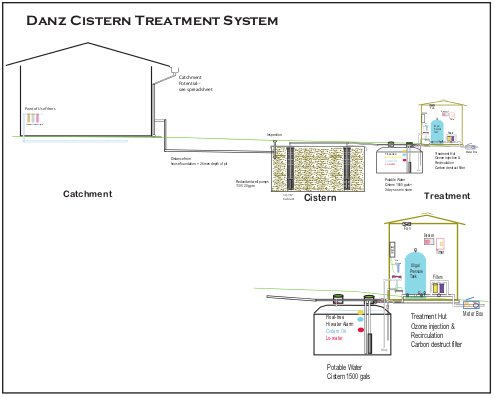Cistern and Ozonator System
This is an integrated cistern/ozonator/rooftop catchment/well water system hybrid. Rooftop catchment and another water line (from the right in the picture) feed into the cistern.
Credits: Dan the Irreverend
Download higher resolution PDF: File:Roofcatch.pdf
Download rooftop catchment potential spreadsheet: File:Catchment.xls
Design
- Get cheapest washed gravel - small works better
- Porosity of pea gravel is .65
- Dan puts liner (check http://www.reefindustries.com/) in the cistern, then rock, then culverts, fills it up.
- Need to find sourcing information for liner
- Need closing detail for seams and around culverts
- Gallon/day/person - 15 gal/day bath-cooking-water-animals
- 3-1 long to wide
- 2x depth away from house
- dig a ditch next to gravel tank - put side and top liner there - roll a piece of PVC, screw down to keep anything from getting in there.
- Culvert with pie cuts
- Culvert looks like a riser. Riser comes out of ground 6" - so no flood water.
- Go down to 1 micron - 500 gallon tank
- Reef Industries - 19 mil - should be about 30 cents per square foot.
- pressure-compensated septic drip tubing at Home Depot
Build
- Type of gravel to use:
- Gravel - Marcin, it looked to me like this was cracked rock, fractured and highly faced?
What you need is what they use in concrete so go to a concrete plant--unless that was what they use for ballast in their concrete. The guy is right, the smaller the pebble the larger the entire void space (more water) you can hold in that stuff. The absolute way to check it is to fill a bucket or two with different materials and then add water, then dump and measure the water. Ideally you want 3/8 to 1/2 inch pea gravel, not cracked limestone or chirt. But, in the end you use what you can afford! The guy also was right about the critical mater of clean. Fill a bucket with the selected materials. Fill it up with a hose. Slosh it around and dump out the wet stuff. If you get a full cup of dirt and "fines" like sand, okay, but more than that you will pay for water loss you cannot see when they dump it. Small, round, and very clean is the stuff you really need! That's from Goethe and me!
